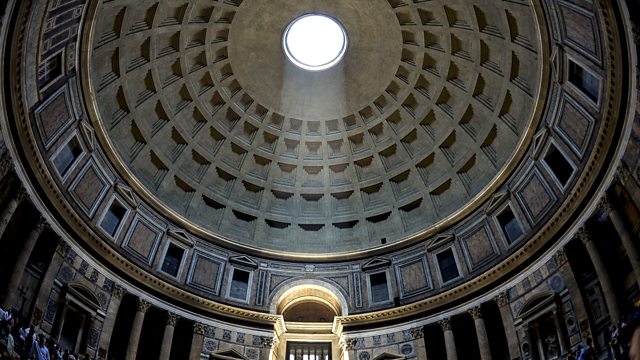Concrete: Foundation of the modern world
How concrete has evolved from Roman bridges and amphitheatres to gigantic, modern, engineering projects.
It has been around since before 6,000BC, the Ancient Egyptians used a version of it and so did the Romans. Nowadays it is the most common man-made building material in the world, used for some of the planet's biggest engineering projects - and some of the smallest. It has not always been loved by the public but architects and designers see both practicality and beauty. There is also an environmental issue - the production of concrete has a major environmental impact. So what of its future? Bridget Kendall explores concrete with architect Anupama Kundoo, design critic and writer Stephen Bayley and engineer and scientist professor Paulo Monteiro.
(Photo: The ceiling of the Pantheon in Rome is an example of Roman concrete construction. Credit: Getty Images)
Last on
More episodes
Previous
Clip
-
![]()
Self-Healing Concrete
Duration: 01:04
Paulo Monteiro
Paulo Monteiro is the Roy W. Carlson Distinguished Professor and Faculty Scientist at the Department of Civil and Environmental Engineering at the University of California, Berkeley. His primary research interests are Concrete Behaviour and Structural Materials. He is a world specialist in the structure of building materials and is very interested in making concrete production greener and making concrete聽 more interesting to use and even lighter and stronger.
Stephen Bayley
Stephen Bayley is an author, critic, columnist, consultant, broadcaster, debater and curator. Over the past thirty years he has challenged the way the world thinks about design. With Terence Conran he created the influential Boilerhouse Project in the Victoria & Albert Museum. This became London鈥檚 most successful exhibition space during the eighties and evolved into the influential Design Museum which Mrs Thatcher opened in 1989. Stephen wants to challenge the prejudices he thinks many people have about concrete.
Anupama Kundoo
Anupama Kundoo鈥檚 internationally recognised and
award-winning architecture practice started in 1990, demonstrates a strong
focus on material research and experimentation towards an architecture that has
low environmental impact and is appropriate to the socio-economic context.聽
Anupama has built extensively in India and has had
experience of working, researching and teaching in a variety of cultural
contexts across the world:聽 She is
interested, like Paulo, in using concrete more efficiently and developing new
ways to use it- practically with developments like ferrocement and
aesthetically with the use of lighter, thinner slabs and the use of colour.
Broadcasts
- Mon 17 Oct 2016 01:06GMT麻豆官网首页入口 World Service except Americas and the Caribbean, Australasia & News Internet
- Mon 17 Oct 2016 04:06GMT麻豆官网首页入口 World Service Americas and the Caribbean
- Tue 18 Oct 2016 23:06GMT麻豆官网首页入口 World Service except News Internet
- Wed 19 Oct 2016 01:06GMT麻豆官网首页入口 World Service Australasia
Featured in...
![]()
Technology and innovations—The Forum
Machines, materials and methods that changed how the world works
![]()
Art, design and style—The Forum
Visions that sparked the world's imagination
Podcast
-
![]()
The Forum
The programme that explains the present by exploring the past





